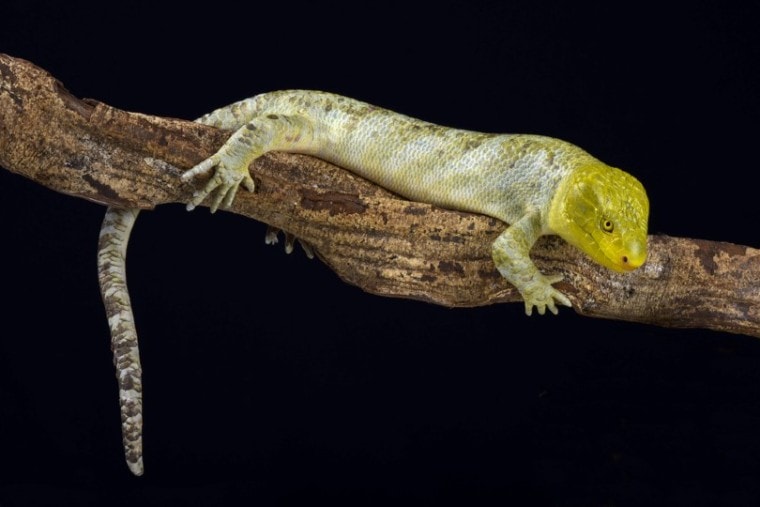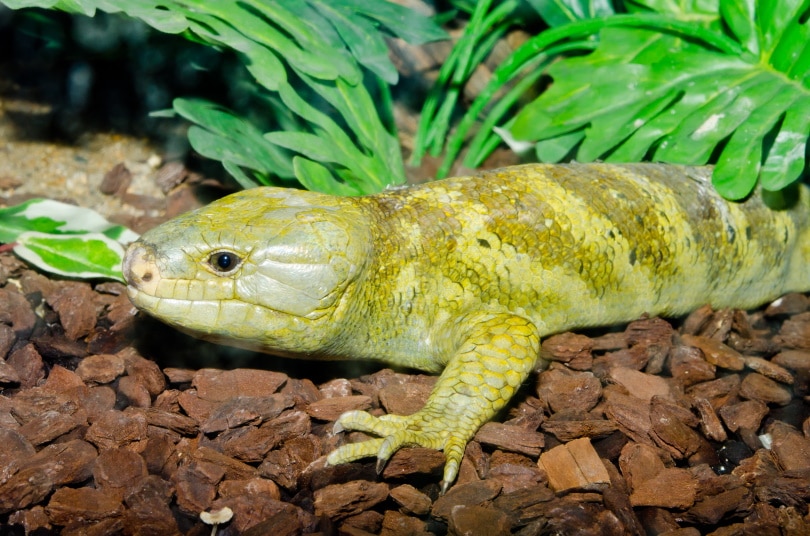
The Monkey-Tailed Skink has several names, including the Solomon Island Skink. This is because they are native to the Solomon Islands and are only found in the wild there. They are the largest species of skinks and, in the wild, live in the trees of the rainforest. The Monkey-Tailed Skink is a fairly popular pet for reptile keepers because they are interesting to observe and can live for a long time if properly cared for.

Quick Facts About Monkey-Tailed Skink

| Species Name: | Corucia Zebrata |
| Common Name: | Monkey-Tailed Skink, Solomon Island Skink, Prehensile Tailed Skink, Giant Skink |
| Care Level: | Medium |
| Lifespan: | 25 to 30 years |
| Adult Size: | 24 to 32 inches |
| Diet: | Herbivores |
| Minimum Enclosure Size: | 5’ H x 3’ W x 6’ L |
| Temperature & Humidity: | 75º to 80º Fahrenheit, 70% to 90% humidity |
Do Monkey-Tailed Skinks Make Good Pets?
Monkey-Tailed Skinks are popular pets for reptile fans, and they can make good pets if you can properly take care of them and give them the space they need. However, it is crucial that you do your research and ensure that you are getting a captive-bred skink, not one that has been taken from the wild. These skinks are only found in the wild on the Solomon Islands. The pet trade has harmed their numbers in the wild. Many captive breeding programs in the United States have helped cut down on the number taken from the wild, but the problem still exists.
Appearance
The Monkey-Tailed Skink is the largest species of skink. When fully grown, they can reach a length of 32 inches, half of this is their tail. The skink’s tail is prehensile, which means it can wrap around things like tree branches to aid in climbing. They have long bodies as well and short, thick, muscular legs.
Their scales are dark green and have dark brown or black spots. The underside of a Monkey-Tailed Skink is light green or yellow. They also have long, thick toenails to help with climbing.

How to Take Care of Monkey-Tailed Skinks

Habitat Conditions & Setup
As is the case with all reptile pets, the Monkey-Tailed Skink has some very specific requirements to ensure a happy and healthy life. These include the right enclosure, lighting, temperature, and bedding.
Enclosure
At a minimum, the enclosure should be at least 5’ H x 3’ W x 6’ L. A larger space is perfectly fine as it gives them more room to roam around. It is important to keep the tank very clean to prevent illness and infection. Most enclosures are constructed of wood, mesh, and plexiglass to ensure proper humidity levels are maintained. The Monkey-Tailed Skink is a very active and curious reptile. There should be plenty of materials in their habitat that they can climb and hide under. You should also rearrange and change out their climbing materials and decor frequently to keep them busy.
Lighting
Monkey-Tailed Skinks need exposure to UVB light for proper calcium metabolization. They should have UVB exposure for 8 to 12 hours per day. For the remainder of the time, the enclosure should be dark to mimic natural day and night periods. They also need a heat lamp to provide them with a basking spot of at least 90º to 100º Fahrenheit.
Heating (Temperature & Humidity)
The ambient temperature in a Monkey-Tailed Skink’s habitat should be kept between 75º and 80º Fahrenheit. They can easily overheat if the temperature rises above 85º Fahrenheit. The humidity level also needs to be kept quite high. Ideally, it should always be at least 60% humidity or higher in their enclosure.
Substrate
Sphagnum moss, coconut fiber, or bark all make good substrates for a Monkey-Tailed Skink. Whichever you choose, it needs to be changed out frequently to keep the enclosure clean and bacteria-free.
| Tank Recommendations | |
| Tank Type: | Enclosure – wood, mesh, plexiglass |
| Lighting: | UVB and heat lamp; 12 hours daylight, 12 hours dark |
| Heating: | Ambient 75º to 80º Fahrenheit; Basking 90º to 100º Fahrenheit |
| Best Substrate: | Sphagnum moss, coconut fiber, bark |

Feeding Your Monkey-Tailed Skink

The Monkey-Tailed Skink is a herbivore, although in the wild they will occasionally eat small animals or insects. In captivity, your Monkey-Tailed Skink should be provided with a variety of fruits and vegetables. The majority should be fresh leafy greens such as lettuce, kale, spinach, and others. They like many vegetables and can have green beans, cooked squash, carrots, broccoli, corn, and peas, along with others. Fruits should be given on occasion. Good fruit choices include apples, bananas, peaches, mango, kiwi, and papaya.
They should also have access to fresh, clean water at all times. It should be changed daily as they may bathe in and defecate in their water dish.
| Diet Summary | |
| Fruits: | 10% of diet |
| Vegetables: | 20% of diet |
| Leafy Greens: | 60%-70% of diet |
| Supplements Required: | Powdered calcium once per week |
Keeping Your Monkey-Tailed Skink Healthy
If you have a Monkey-Tailed Skink as a pet, you will need to make sure you have a reptile or exotic animal veterinarian nearby in case of health problems. The biggest keys to a healthy pet skink are proper enclosure temperature, humidity, lighting, and cleanliness.
Common Health Issues

Lifespan
If they are properly cared for, Monkey-Tailed Skinks can live for 25 to 30 years in captivity. The best way to ensure that your pet has a long, happy life is to make sure you are providing them with a large enclosure with plenty of enrichment materials to exercise their natural climbing instinct. A clean, well-maintained enclosure will protect against parasites and infection.

Breeding
In the wild, Monkey-Tailed Skinks live in small groups. The group will usually include one male and two or three females. The females give birth to live young after a gestation period of about 8 months. In captivity, it is important to never keep two male skinks together as they are very territorial. Two females or a male and female can be kept together without problems.
Are Monkey-Tailed Skinks Friendly? Our Handling Advice
Monkey-tailed skinks do not really enjoy handling by humans. It is best to keep them as pets to care for and observe, rather than handle. They have very sharp claws and a strong bite that can be painful. It is best to avoid handling them as they can become stressed and agitated when touched too frequently. When you do need to handle them, you should always wear thick gloves to protect yourself.
Shedding & Brumation: What to Expect
Monkey-Tailed Skinks shed their skin every 4 to 6 weeks. The process is made much easier by maintaining high humidity levels in their enclosure. You may want to mist their tank frequently during shedding periods to help ease the process. You will also likely notice that your skink spends more time sitting in their water dish during this time as well.
Since they are only found in the Solomon Islands in the wild, the Monkey-Tailed Skink does not generally have a brumation period naturally. However, some breeders will introduce cooler temperatures to encourage brumation in captivity. This is not necessary for the health of your pet.
How Much Do Monkey-Tailed Skinks Cost?
First, you should always do your research and make sure you are only getting your Monkey-Tailed Skink from a reputable breeder. It should be bred in captivity, not taken from the wild. The average cost of a Monkey-Tailed Skink bred in captivity ranges from $450 to $700.
Care Guide Summary

Summary
The Monkey-Tailed Skink is not a pet for the inexperienced reptile owner. They have specific care needs and require a lot of space. They are curious and active and are interesting to observe for the dedicated caretaker.
See also: 100+ Lizard Names: Ideas for Scaly & Curious Reptiles
Featured Image Credit: reptiles4all, Shutterstock







